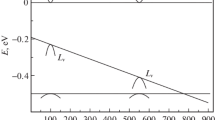Abstract
The thermoelectric properties of p-РbТе were studied theoretically at the level of acceptor doping within 5 × 1019 to 4 × 1020 cm–3 and in the 300–900 K temperature range. The three-band model of the electron energy spectrum of PbTe that was used in the calculations includes not only the bands of light electrons and holes in L-points of Brillouin zone but also the band of heavy holes in its Σ-points. The heavy Σ-band plays an important role in increasing the thermoelectric figure of merit of this material at high levels of acceptor doping. The calculated values of thermoelectric characteristics are very sensitive to the doping level. The calculations revealed that thermoelectric figure of merit increases with the doping level up to ZT ≈ 1.3 at 900 К. This maximum is located near the temperature at which the peaks of the bands of light and heavy holes coincide in energy and sharp singularity of density of states arises in the valence band; the Fermi energy is not far from the singularity.



Similar content being viewed by others
REFERENCES
T. M. Tritt and M. A. Subramanian, MRS Bull. 31, 188 (2006).
H. Ohita, Mater. Today 10, 44 (2007).
A. V. Dmitriev and I. P. Zvyagin, Phys.-Usp. 53, 789 (2010).
A. Ishida, T. Yamada, D. Cao, et al., J. Appl. Phys. 106, 023718 (2009).
J. Andrulakis, I. Todorov, D.-Y. Chung, et al., Phys. Rev. B 82, 115209 (2010).
Y. Pei, A. LaLonde, S. Iwanga, and G. J. Snyder, Energy Environ. Sci. 4, 2085 (2011).
H. Preier, Appl. Phys. 20, 189 (1989).
Z. Gibbs, H. Kim, H. Wang, et al., Appl. Phys. Lett. 103, 262109 (2013).
N. I. Babenko and A. V. Dmitriev, J. Appl. Phys. 121, 025704 (2017).
N. F. Mott and H. Jones, The Theory of the Properties of Metals and Alloys (Clarendon, Oxford, 1936).
N. I. Babenko and A. V. Dmitriev, Moscow Univ. Phys. Bull. 72, 582 (2017). https://doi.org/ 10.3103/S0027134917060029
N. I. Babenko and A. V. Dmitriev, Moscow Univ. Phys. Bull. 72, 587 (2017). https://doi.org/ 10.3103/S0027134917060030
A. V. Dmitriev and E. S. Tkacheva, J. Electron. Mater. 43, 1280 (2014).
A. V. Dmitriev and E. S. Tkacheva, Moscow Univ. Phys. Bull. 69, 243 (2014). https://doi.org/ 10.3103/S0027134914030072
S. D. Beneslavskii and A. V. Dmitriev, Solid State Commun. 32, 1175 (1979).
Author information
Authors and Affiliations
Corresponding author
Additional information
Translated by M. Kromin
About this article
Cite this article
Dmitriev, A.V. Calculation of the Thermoelectric Characteristics of Lead Telluride at a High Level of Acceptor Doping. Moscow Univ. Phys. 73, 674–677 (2018). https://doi.org/10.3103/S0027134918060103
Received:
Accepted:
Published:
Issue Date:
DOI: https://doi.org/10.3103/S0027134918060103



